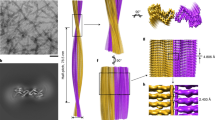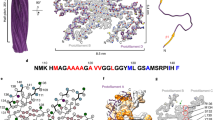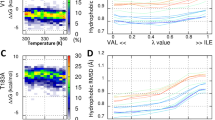Abstract
Incorrectly folded states transiently populated during the protein folding process are potentially prone to aggregation and have been implicated in a range of misfolding disorders that include Alzheimer's and Parkinson's diseases. Despite their importance, however, the structures of these states and the mechanism of their formation have largely escaped detailed characterization because of their short-lived nature. Here we present the structures of all the major states involved in the folding process of a PDZ domain, which include an off-pathway misfolded intermediate. By using a combination of kinetic, protein engineering, biophysical and computational techniques, we show that the misfolded intermediate is characterized by an alternative packing of the N-terminal β-hairpin onto an otherwise native-like scaffold. Our results suggest a mechanism of formation of incorrectly folded transient compact states by which misfolded structural elements are assembled together with more extended native-like regions.
This is a preview of subscription content, access via your institution
Access options
Subscribe to this journal
Receive 12 print issues and online access
$189.00 per year
only $15.75 per issue
Buy this article
- Purchase on Springer Link
- Instant access to full article PDF
Prices may be subject to local taxes which are calculated during checkout







Similar content being viewed by others
References
Fersht, A.R. Structure and Mechanism in Protein Science (Freeman, New York, 1999).
Selkoe, D.J. Folding proteins in fatal ways. Nature 426, 900–904 (2003).
Chiti, F. & Dobson, C.M. Protein misfolding, functional amyloid, and human disease. Annu. Rev. Biochem. 75, 333–366 (2006).
Frydman, J. Folding of newly translated proteins in vivo: the role of molecular chaperones. Annu. Rev. Biochem. 70, 603–647 (2001).
Hartl, F.U. & Hayer-Hartl, M. Molecular chaperones in the cytosol: from nascent chain to folded protein. Science 295, 1852–1858 (2002).
Bukau, B., Weissman, J. & Horwich, A. Molecular chaperones and protein quality control. Cell 125, 443–451 (2006).
Ellgaard, L. & Helenius, A. Quality control in the endoplasmic reticulum. Nat. Rev. Mol. Cell Biol. 4, 181–191 (2003).
Goldberg, A.L. Protein degradation and protection against misfolded or damaged proteins. Nature 426, 895–899 (2003).
Chiti, F. & Dobson, C.M. Amyloid formation by globular proteins under native conditions. Nat. Chem. Biol. 5, 15–22 (2009).
Elad, N. et al. Topologies of a substrate protein bound to the chaperonin GroEL. Mol. Cell 26, 415–426 (2007).
Hartl, F.U. & Hayer-Hartl, M. Converging concepts of protein folding in vitro and in vivo. Nat. Struct. Mol. Biol. 16, 574–581 (2009).
Horwich, A.L. & Fenton, W.A. Chaperonin-mediated protein folding: using a central cavity to kinetically assist polypeptide chain folding. Q. Rev. Biophys. 42, 83–116 (2009).
Matouschek, A., Kellis, J.T. Jr., Serrano, L., Bycroft, M. & Fersht, A.R. Transient folding intermediates characterized by protein engineering. Nature 346, 440–445 (1990).
Capaldi, A.P., Kleanthous, C. & Radford, S.E. Im7 folding mechanism: misfolding on a path to the native state. Nat. Struct. Biol. 9, 209–216 (2002).
Friel, C.T., Smith, D.A., Vendruscolo, M., Gsponer, J. & Radford, S.E. The mechanism of folding of Im7 reveals competition between functional and kinetic evolutionary constraints. Nat. Struct. Mol. Biol. 16, 318–324 (2009).
Ivarsson, Y., Travaglini-Allocatelli, C., Brunori, M. & Gianni, S. Engineered symmetric connectivity of secondary structure elements highlights malleability of protein folding pathways. J. Am. Chem. Soc. 131, 11727–11733 (2009).
Korzhnev, D.M., Religa, T.L., Banachewicz, W., Fersht, A.R. & Kay, L.E. A transient and low-populated protein-folding intermediate at atomic resolution. Science 329, 1312–1316 (2010).
Religa, T.L., Markson, J.S., Mayor, U., Freund, S.M. & Fersht, A.R. Solution structure of a protein denatured state and folding intermediate. Nature 437, 1053–1056 (2005).
Wu, Y., Vadrevu, R., Kathuria, S., Yang, X.Y. & Matthews, C.R. A tightly packed hydrophobic cluster directs the formation of an off-pathway sub-millisecond folding intermediate in the alpha subunit of tryptophan synthase, a TIM barrel protein. J. Mol. Biol. 366, 1624–1638 (2007).
Nabuurs, S.M., Westphal, A.H. & van Mierlo, C.P.M. Noncooperative formation of the off-pathway molten globule during folding of the alpha-beta parallel protein apoflavodoxin. J. Am. Chem. Soc. 131, 2739–2746 (2009).
Ivarsson, Y., Travaglini-Allocatelli, C., Morea, V., Brunori, M. & Gianni, S. The folding pathway of an engineered circularly permuted PDZ domain. Protein Eng. Des. Sel. 21, 155–160 (2008).
Morais Cabral, J.H. et al. Crystal structure of a PDZ domain. Nature 382, 649–652 (1996).
Krojer, T., Garrido-Franco, M., Huber, R., Ehrmann, M. & Clausen, T. Crystal structure of DegP (HtrA) reveals a new protease-chaperone machine. Nature 416, 455–459 (2002).
Liao, D.I., Qian, J., Chisholm, D.A., Jordan, D.B. & Diner, B.A. Crystal structures of the photosystem II D1 C-terminal processing protease. Nat. Struct. Biol. 7, 749–753 (2000).
Calosci, N. et al. Comparison of successive transition states for folding reveals alternative early folding pathways of two homologous proteins. Proc. Natl. Acad. Sci. USA 105, 19241–19246 (2008).
Chi, C.N. et al. A conserved folding mechanism for PDZ domains. FEBS Lett. 581, 1109–1113 (2007).
Gianni, S. et al. Kinetic folding mechanism of PDZ2 from PTP-BL. Protein Eng. Des. Sel. 18, 389–395 (2005).
Gianni, S. et al. A PDZ domain recapitulates a unifying mechanism for protein folding. Proc. Natl. Acad. Sci. USA 104, 128–133 (2007).
Ivarsson, Y. et al. An on-pathway intermediate in the folding of a PDZ domain. J. Biol. Chem. 282, 8568–8572 (2007).
Jemth, P. & Gianni, S. PDZ domains: folding and binding. Biochemistry 46, 8701–8708 (2007).
Ivarsson, Y., Travaglini-Allocatelli, C., Brunori, M. & Gianni, S. Folding and misfolding in a naturally occurring circularly permuted PDZ domain. J. Biol. Chem. 283, 8954–8960 (2008).
Fersht, A.R., Matouschek, A. & Serrano, L. The folding of an enzyme. I. Theory of protein engineering analysis of stability and pathway of protein folding. J. Mol. Biol. 224, 771–782 (1992).
Fersht, A.R. & Sato, S. Phi-value analysis and the nature of protein-folding transition states. Proc. Natl. Acad. Sci. USA 101, 7976–7981 (2004).
Mayor, U. et al. The complete folding pathway of a protein from nanoseconds to microseconds. Nature 421, 863–867 (2003).
Li, L., Mirny, L.A. & Shakhnovich, E.I. Kinetics, thermodynamics and evolution of non-native interactions in a protein folding nucleus. Nat. Struct. Biol. 7, 336–342 (2000).
Ozkan, S.B., Bahar, I. & Dill, K.A. Transition states and the meaning of Phi-values in protein folding kinetics. Nat. Struct. Biol. 8, 765–769 (2001).
Ventura, S. et al. Conformational strain in the hydrophobic core and its implications for protein folding and design. Nat. Struct. Biol. 9, 485–493 (2002).
Paci, E., Vendruscolo, M., Dobson, C.M. & Karplus, M. Determination of a transition state at atomic resolution from protein engineering data. J. Mol. Biol. 324, 151–163 (2002).
Vendruscolo, M., Paci, E., Dobson, C.M. & Karplus, M. Three key residues form a critical contact network in a protein folding transition state. Nature 409, 641–645 (2001).
Gsponer, J. et al. Determination of an ensemble of structures representing the intermediate state of the bacterial immunity protein Im7. Proc. Natl. Acad. Sci. USA 103, 99–104 (2006).
Salvatella, X., Dobson, C.M., Fersht, A.R. & Vendruscolo, M. Determination of the folding transition states of barnase by using PhiI-value-restrained simulations validated by double mutant PhiIJ-values. Proc. Natl. Acad. Sci. USA 102, 12389–12394 (2005).
Bryngelson, J.D., Onuchic, J.N., Socci, N.D. & Wolynes, P.G. Funnels, pathways, and the energy landscape of protein folding: a synthesis. Proteins 21, 167–195 (1995).
Ferreiro, D.U., Hegler, J.A., Komives, E.A. & Wolynes, P.G. Localizing frustration in native proteins and protein assemblies. Proc. Natl. Acad. Sci. USA 104, 19819–19824 (2007).
Sutto, L., Lätzer, J., Hegler, J.A., Ferreiro, D.U. & Wolynes, P.G. Consequences of localized frustration for the folding mechanism of the IM7 protein. Proc. Natl. Acad. Sci. USA 104, 19825–19830 (2007).
Tartaglia, G.G. et al. Prediction of aggregation-prone regions in structured proteins. J. Mol. Biol. 380, 425–436 (2008).
Hubner, I.A., Lindberg, M., Haglund, E., Oliveberg, M. & Shakhnovich, E.I. Common motifs and topological effects in the protein folding transition state. J. Mol. Biol. 359, 1075–1085 (2006).
Lindberg, M., Tangrot, J. & Oliveberg, M. Complete change of the protein folding transition state upon circular permutation. Nat. Struct. Biol. 9, 818–822 (2002).
Lindberg, M.O. & Oliveberg, M. Malleability of protein folding pathways: a simple reason for complex behaviour. Curr. Opin. Struct. Biol. 17, 21–29 (2007).
Lindberg, M.O. et al. Folding of circular permutants with decreased contact order: general trend balanced by protein stability. J. Mol. Biol. 314, 891–900 (2001).
Klimov, D.K. & Thirumalai, D. Symmetric connectivity of secondary structure elements enhances the diversity of folding pathways. J. Mol. Biol. 353, 1171–1186 (2005).
Jemth, P. et al. Demonstration of a low-energy on-pathway intermediate in a fast-folding protein by kinetics, protein engineering, and simulation. Proc. Natl. Acad. Sci. USA 101, 6450–6455 (2004).
Jackson, S.E. & Fersht, A.R. Folding of chymotrypsin inhibitor 2. 1. Evidence for a two-state transition. Biochemistry 30, 10428–10435 (1991).
Acknowledgements
We acknowledge financial support from the Italian Ministero dell'Istruzione dell'Università e della Ricerca (2007B57EAB_004, 20074TJ3ZB_005, RBRN07BMCT_007) (S.G., Y.I., C.T.-A., M.B.), the Wenner Green Foundations (Y.I.), the Istituto Pasteur-Fondazione Cenci Bolognetti (Y.I.), European Molecular Biology Organization (Y.I.), Engineering and Physical Sciences Research Council (A.D.S.), Biotechnology and Biological Sciences Research Council (M.V.) and the Royal Society (M.V.).
Author information
Authors and Affiliations
Contributions
S.G., Y.I., C.T.-A. and M.B. conceived and designed the experimental work; A.D.S. and M.V. conceived and designed the computational work; Y.I. expressed and purified the protein samples; S.G. and Y.I. conducted the experiments; A.D.S. did the simulations; S.G., Y.I., A.D.S., C.T.-A., M.B. and M.V. analyzed the data and wrote the paper.
Corresponding author
Ethics declarations
Competing interests
The authors declare no competing financial interests.
Supplementary information
Supplementary Text and Figures
Supplementary Figure 1 and Supplementary Table 1 (PDF 479 kb)
Rights and permissions
About this article
Cite this article
Gianni, S., Ivarsson, Y., De Simone, A. et al. Structural characterization of a misfolded intermediate populated during the folding process of a PDZ domain. Nat Struct Mol Biol 17, 1431–1437 (2010). https://doi.org/10.1038/nsmb.1956
Received:
Accepted:
Published:
Issue Date:
DOI: https://doi.org/10.1038/nsmb.1956
This article is cited by
-
The structural basis of nanobody unfolding reversibility and thermoresistance
Scientific Reports (2018)
-
Kinetic modelling indicates that fast-translating codons can coordinate cotranslational protein folding by avoiding misfolded intermediates
Nature Communications (2014)
-
Solution Dependence of the Collisional Activation of Ubiquitin [M + 7H]7+ Ions
Journal of the American Society for Mass Spectrometry (2014)
-
Single-molecule fluorescence reveals sequence-specific misfolding in multidomain proteins
Nature (2011)



